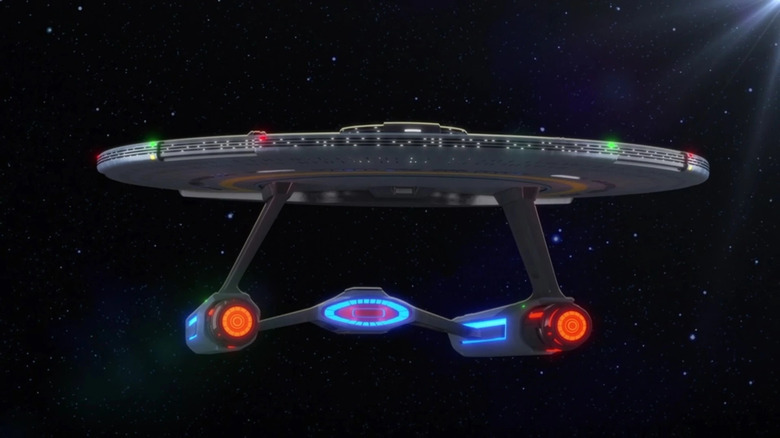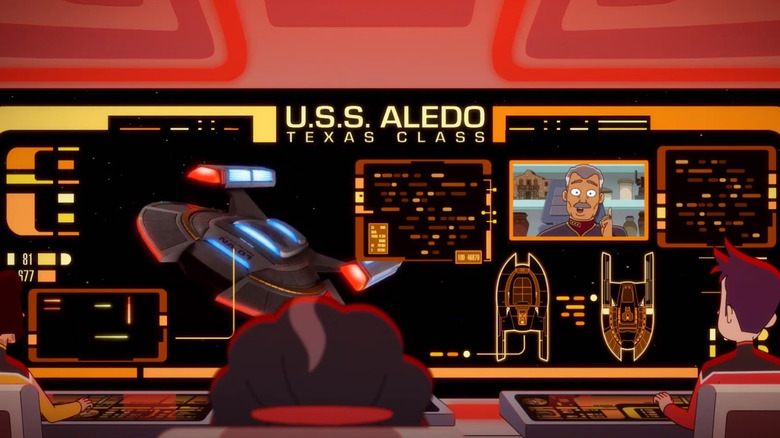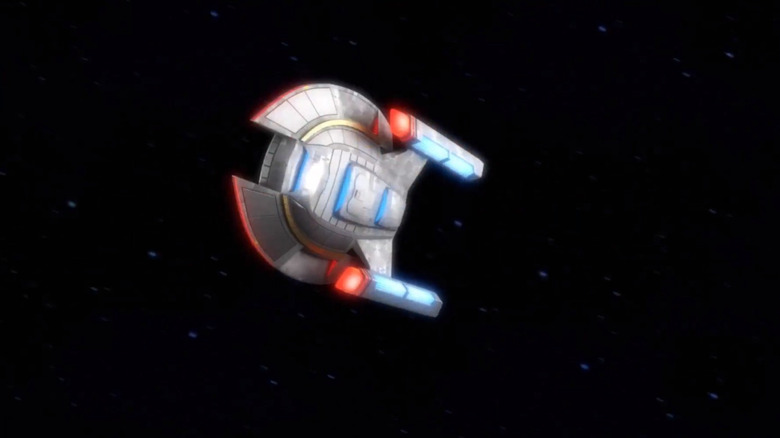Attention Ship Nerds: Star Trek: Lower Decks Introduces A New Class Of Starship
This post contains spoilers for the latest episode of "Star Trek: Lower Decks."
At the climax of "Trusted Sources," the latest episode of "Star Trek: Lower Decks," the U.S.S. Cerritos is beset by a fleet of attacking Breen warships. Hopelessly outgunned, the Cerritos doesn't fare well in battle. Its photon torpedoes are shot out of the sky and the shields are failing. Right when doom is apparently at hand, the cavalry charges in. A heretofore unseen Starship called the U.S.S. Aledo flies into the fray, phasers blazing. When Captain Freeman (Dawnn Lewis) tries to hail their savior, the ship doesn't answer. Vice Admiral Buen Amigo (Carlos Alazraqui) appears on a video screen to explain that the Aledo is, in fact, a full automated ship, the first in a new fleet of spacebound Starfleet drones.
The name of this new Starship class? The Texas Class.
This will, of course, set off the red alert klaxon in the brains of any Trekkie. An armed, unmanned starship cannot possibly be used for constructive means. While it was certainly helpful in a battle situation, and wouldn't have suffered any casualties if destroyed, the potential for malfeasance is right on the surface. What's to prevent an alien species from capturing an unmanned starship and reprogramming it for more aggressive purposes? What if the ship's automation fails, and it opens fire on a planet's surface by mistake?
Most importantly, Trekkies have repeatedly witnessed computers gain sentience on "Star Trek" — from hologram Moriarity, to the exocomps, to the Doctor on the U.S.S. Voyager, to the computer systems on the U.S.S. Discovery. There's every reason to believe the Aledo would gain a will of its own as a matter of course. It will take some deep breaths for many Trekkies to begin pondering the actual practical ramifications of a remote-controlled ship.
Breaking down Starship tech
There are certain technical limitations that have been baked into "Star Trek" from the start, often for practical or dramatic reasons. It's a well-known piece of trivia that the Enterprise's transporters were written into the show as a cost-saving measure; it was easier to make the beaming effect than it was to film a shuttlecraft landing on new planet every week. What's more, the show would be unsatisfying to watch if Starfleet could do anything they wanted via "magical" tech means.
Starships, for instance, still have to be built at Utopia Planetia, taking years of assembly and construction. They cannot be replicated out of this air the same way the Enterprise-D does with its food. As author Phil Farrand once said in his indispensable book "The Nitpicker's Guide for Next Generation Trekkers," if someone were powerful enough to replicate an entire fleet of starships at the push of a button, they likely wouldn't need starships.
The same is true of Trek's warp engines. "Star Trek" has always nodded in the direction of real science, and it acknowledges just how very big the Milky Way Galaxy actually is. In the world of "Lower Decks," only one quadrant of the galaxy has been explored. Most of the galaxy remains distant and mysterious, as it's simply too far away to travel to. The Milky Way, to remind the reader of their fifth grade astronomy lessons, is about 105,000 lightyears across.
If a starship were traveling Warp 9 (one of the higher speeds achievable in "Star Trek"), it would take 70 straight years of travel to traverse the distance. Warp 9 is about 1,500 times the speed of light. The galaxy is so big that even a fictional propulsion system can't zip across it easily.
The future is automated ships?
Given Trek's eye for technical limitations, the idea of a ship being run automatically has typically been shied away from by series writers. Indeed, given that Trek has also had a close eye on its own canon, any brand new technology introduced in one show would necessarily have to be commented on — and even employed — in another. "Lower Decks" has reintroduced certain technologies into its canon that had previously been mentioned on older shows. The robotic character of Ensign Peanut Hamper, for instance, was an expansion of the exocomps story from "Star Trek: The Next Generation." Magical new technologies, however, need to be treated with a light touch, lest they have the potential to fundamentally alter the very fabric of "Star Trek." One of the central dramatic errors of "Star Trek: Discovery" is that the title ship can literally teleport anywhere in the universe, eliminating the need for trekking. If all Starfleet ships were able to share teleportation technology on a massive scale, everything in the universe would change in an instant. Travel would be a thing of the past.
Automated ships, it seems, would be useful for many reasons. Not just in combat as seen on "Trusted Sources," but in rescue missions, or study missions in dangerous areas. An automated ship could serve as a sentry in diplomatic standoffs, or serve as escorts for other, under-equipped ships. They would certainly be handy for transporting hazardous materials like antimatter or viral samples. Provided they are treated like mechanical workhorses, automated ships would be one of the more useful pieces of tech in Trek.
Give them artificial intelligence, however, and you're just asking for trouble.


